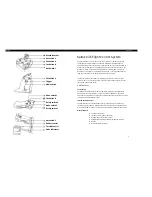
EbV
Product documentation THETA NORM/UNIT
10-1
10
Cascading of heat generators in the bus system
10.1
General description of cascading of control devices
In heating applications, a cascade is the hydraulic connection of several heat generators of different types
to create a complex of heat generators.
The advantage compared to a single heat generator of the same capacity is that only the necessary number
of heat generators supply to the heat demand. Heat generators which are not required are not switched on.
This way, losses are minimised and the running time of the individual heat generators is prolonged
significantly, which leads to a large increase in efficiency.
This type of plant design is especially suitable for plants of middle and high capacities.
Function:
In its standard version, the control system features the possibility to couple and
cascade several boilers in a simple way. Also, the cascade control is independent of
the type of heat generators to be combined. For instance, condensing boilers can be
easily combined with atmospheric gas boilers.
The system automatically recognizes a cascade by checking if several central
devices have programmed a heat generator, or if more than one condensing boiler
is connected to a central device. In cascade operation, an additional cascade
selection level is displayed for handling the parameters in the central device
assigned to bus address 10.
NOTE
Cascade operation excludes 2-stage boiler control. All available stages are switched
by the cascade management. Consequently, the respective parameters of the heat
generator selection level are not available for settings. All controls are governed by
cascade control.
10.2
Functions of the cascade parameter
Switching differential:
Each heat generator has its own switching differential. The cascade switching
differential must be set in such a way that it is always wider than the switching
differential of any individual heat generator.
Switch-on delay:
The afterheating characteristics of the boilers must be taken into account when rating
the heating system. The cascade switch-on delay serves to adjust the system to
start-up delays of the individual boilers. For instance when, after being enabled, the
heat generator delivers its energy into the system (start-up phase, run-in period). The
appropriate setting is the maximum delay time of the boilers in the system.
Switch-off delay:
This parameter controls the rundown of the heat generators to avoid that all heat
generators switch off at the same time when the set cascade switching differential is
exceeded. The setting has to be adjusted to the afterheating characteristics of the
heat generators.
Содержание Controller Series
Страница 2: ......
Страница 8: ...EbV Product documentation THETA NORM UNIT VI...
Страница 10: ...EbV Product documentation THETA NORM UNIT 1 2...
Страница 16: ...EbV Product documentation THETA NORM UNIT 2 6...
Страница 18: ...EbV Product documentation THETA NORM UNIT 3 2...
Страница 20: ...EbV Product documentation THETA NORM UNIT 4 2...
Страница 70: ...EbV Product documentation THETA NORM UNIT 5 50...
Страница 78: ...EbV Product documentation THETA NORM UNIT 6 8...
Страница 162: ...EbV Product documentation THETA NORM UNIT 10 10...
Страница 170: ...EbV Product documentation THETA NORM UNIT 11 8...
Страница 192: ...PD_THETA NURS_EbV_GB_0460017001_0612 23...
















































